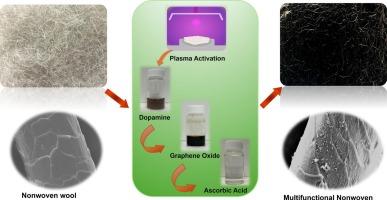等离子辅助的聚多巴胺和氧化石墨烯在羊毛上的绿色组装:走向仿生、多功能无纺布
IF 6.9
2区 材料科学
Q2 CHEMISTRY, PHYSICAL
引用次数: 0
摘要
对羊毛等蛋白质纤维的多功能、环保的表面改性策略仍未得到充分探索。本研究通过整合生物启发策略来制造多功能无纺布羊毛织物,以增强紫外线防护,阻燃性和导电性,从而解决了这一差距。通过层层组装,用聚多巴胺和氧化石墨烯涂覆经过等离子体处理的羊毛,然后用抗坏血酸进行绿色还原。改性织物的紫外线防护能力大幅提高,经多巴胺和氧化石墨烯涂层后,紫外线防护系数从 ~ 50(未经处理的羊毛)上升到250以上,这归功于混合涂层的强紫外线吸收和光散射。热稳定性和阻燃性得到显著改善,热解燃烧流量热测试表明,炭产率从14.2 %提高到30.3 %,峰值放热率从135.5降低到66.1 W/g。此外,电导率测量证实了羊毛成功转化为导电纺织品,减少氧化石墨烯涂层的样品使LED电路照明,而未经处理的羊毛保持绝缘。这项研究提出了一种简单的、生物启发的方法,通过环保的过程来设计多功能羊毛纺织品。改进的热稳定性,防紫外线和导电性使天然羊毛材料有望用于防护和可穿戴电子产品应用。本文章由计算机程序翻译,如有差异,请以英文原文为准。

Plasma-assisted green assembly of polydopamine and graphene oxide on wool: Toward bioinspired, multifunctional nonwoven
Multifunctional, environmentally benign surface modification strategies for proteinaceous fibres like wool remain underexplored. This study addresses this gap by integrating a bio-inspired strategy to fabricate multifunctional nonwoven wool fabrics with enhanced UV protection, flame retardancy, and electrical conductivity. Plasma-treated wool was coated with polydopamine and graphene oxide via layer-by-layer assembly, followed by green reduction using ascorbic acid. The modified fabrics exhibited a substantial increase in UV protection, with the ultraviolet protection factor rising from ∼50 (untreated wool) to over 250 after coating with dopamine and graphene oxide, attributed to the strong UV absorption and light scattering of the hybrid coating. Thermal stability and flame retardancy were significantly improved, as evidenced by increased char yield (from 14.2 % to 30.3 %) and decreased peak heat release rate (from 135.5 to 66.1 W/g) in Pyrolysis Combustion Flow Calorimetry tests. Furthermore, conductivity measurements confirmed the successful transformation of wool into a conductive textile, with reduced graphene oxide coated samples enabling the illumination of an LED circuit, while untreated wool remained insulating. This study presents a facile and bio-inspired approach to engineering multifunctional wool textiles through environmentally friendly processes. The improved thermal stability, UV protection, and conductivity make natural wool materials promising for protective and wearable electronics applications.
求助全文
通过发布文献求助,成功后即可免费获取论文全文。
去求助
来源期刊

Applied Surface Science
工程技术-材料科学:膜
CiteScore
12.50
自引率
7.50%
发文量
3393
审稿时长
67 days
期刊介绍:
Applied Surface Science covers topics contributing to a better understanding of surfaces, interfaces, nanostructures and their applications. The journal is concerned with scientific research on the atomic and molecular level of material properties determined with specific surface analytical techniques and/or computational methods, as well as the processing of such structures.
 求助内容:
求助内容: 应助结果提醒方式:
应助结果提醒方式:


